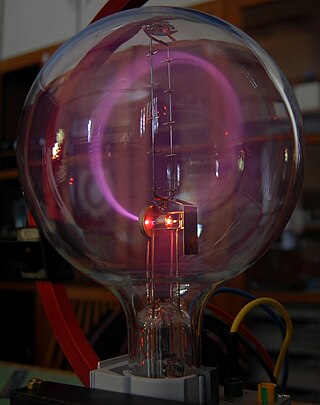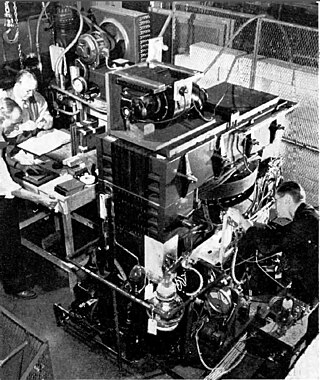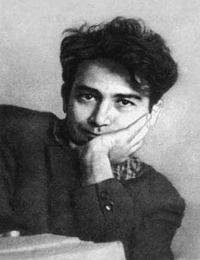Related Research Articles

Cathode rays or electron beams (e-beam) are streams of electrons observed in discharge tubes. If an evacuated glass tube is equipped with two electrodes and a voltage is applied, glass behind the positive electrode is observed to glow, due to electrons emitted from the cathode. They were first observed in 1859 by German physicist Julius Plücker and Johann Wilhelm Hittorf, and were named in 1876 by Eugen Goldstein Kathodenstrahlen, or cathode rays. In 1897, British physicist J. J. Thomson showed that cathode rays were composed of a previously unknown negatively charged particle, which was later named the electron. Cathode-ray tubes (CRTs) use a focused beam of electrons deflected by electric or magnetic fields to render an image on a screen.
In physics, mean free path is the average distance over which a moving particle travels before substantially changing its direction or energy, typically as a result of one or more successive collisions with other particles.

An ion source is a device that creates atomic and molecular ions. Ion sources are used to form ions for mass spectrometers, optical emission spectrometers, particle accelerators, ion implanters and ion engines.

Inertial electrostatic confinement, or IEC, is a class of fusion power devices that use electric fields to confine the plasma rather than the more common approach using magnetic fields found in magnetic confinement fusion (MCF) designs. Most IEC devices directly accelerate their fuel to fusion conditions, thereby avoiding energy losses seen during the longer heating stages of MCF devices. In theory, this makes them more suitable for using alternative aneutronic fusion fuels, which offer a number of major practical benefits and makes IEC devices one of the more widely studied approaches to fusion.
Accelerator physics is a branch of applied physics, concerned with designing, building and operating particle accelerators. As such, it can be described as the study of motion, manipulation and observation of relativistic charged particle beams and their interaction with accelerator structures by electromagnetic fields.
In physics, a charge carrier is a particle or quasiparticle that is free to move, carrying an electric charge, especially the particles that carry electric charges in electrical conductors. Examples are electrons, ions and holes. The term is used most commonly in solid state physics. In a conducting medium, an electric field can exert force on these free particles, causing a net motion of the particles through the medium; this is what constitutes an electric current. The electron and the proton are the elementary charge carriers, each carrying one elementary charge (e), of the same magnitude and opposite sign.

Quadrupole magnets, abbreviated as Q-magnets, consist of groups of four magnets laid out so that in the planar multipole expansion of the field, the dipole terms cancel and where the lowest significant terms in the field equations are quadrupole. Quadrupole magnets are useful as they create a magnetic field whose magnitude grows rapidly with the radial distance from its longitudinal axis. This is used in particle beam focusing.

A Penning trap is a device for the storage of charged particles using a homogeneous magnetic field and a quadrupole electric field. It is mostly found in the physical sciences and related fields of study as a tool for precision measurements of properties of ions and stable subatomic particles, like for example mass, fission yields and isomeric yield ratios. One initial object of study were the so-called geonium atoms, which represent a way to measure the electron magnetic moment by storing a single electron. These traps have been used in the physical realization of quantum computation and quantum information processing by trapping qubits. Penning traps are in use in many laboratories worldwide, including CERN, to store and investigate anti-particles such as antiprotons. The main advantages of Penning traps are the potentially long storage times and the existence of a multitude of techniques to manipulate and non-destructively detect the stored particles. This makes Penning traps versatile tools for the investigation of stored particles, but also for their selection, preparation or mere storage.

A synchrotron is a particular type of cyclic particle accelerator, descended from the cyclotron, in which the accelerating particle beam travels around a fixed closed-loop path. The magnetic field which bends the particle beam into its closed path increases with time during the accelerating process, being synchronized to the increasing kinetic energy of the particles. The synchrotron is one of the first accelerator concepts to enable the construction of large-scale facilities, since bending, beam focusing and acceleration can be separated into different components. The most powerful modern particle accelerators use versions of the synchrotron design. The largest synchrotron-type accelerator, also the largest particle accelerator in the world, is the 27-kilometre-circumference (17 mi) Large Hadron Collider (LHC) near Geneva, Switzerland, built in 2008 by the European Organization for Nuclear Research (CERN). It can accelerate beams of protons to an energy of 13 tera electronvolts (TeV or 1012 eV).
In quantum physics, Regge theory is the study of the analytic properties of scattering as a function of angular momentum, where the angular momentum is not restricted to be an integer multiple of ħ but is allowed to take any complex value. The nonrelativistic theory was developed by Tullio Regge in 1959.

A betatron is a type of cyclic particle accelerator for electrons. It consists of a torus-shaped vacuum chamber with an electron source. Circling the torus is an iron transformer core with a wire winding around it. The device functions similarly to a transformer, with the electrons in the torus-shaped vacuum chamber as its secondary coil. An alternating current in the primary coils accelerates electrons in the vacuum around a circular path. The betatron was the first machine capable of producing electron beams at energies higher than could be achieved with a simple electron gun, and the first circular accelerator in which particles orbited at a constant radius.
A particle-beam weapon uses a high-energy beam of atomic or subatomic particles to damage the target by disrupting its atomic and/or molecular structure. A particle-beam weapon is a type of directed-energy weapon, which directs energy in a particular and focused direction using particles with minuscule mass. Some particle-beam weapons have potential practical applications, e.g. as an antiballistic missile defense system. They have been known by myriad names: particle accelerator guns, ion cannons, proton beams, lightning rays, rayguns, etc.

Gurgen Ashotovich Askaryan was a prominent Soviet - Armenian physicist, famous for his discovery of the self-focusing of light, pioneering studies of light-matter interactions, and the discovery and investigation of the interaction of high-energy particles with condensed matter.
An ion pump is a type of vacuum pump which operates by sputtering a metal getter. Under ideal conditions, ion pumps are capable of reaching pressures as low as 10−11 mbar. An ion pump first ionizes gas within the vessel it is attached to and employs a strong electrical potential, typically 3–7 kV, which accelerates the ions into a solid electrode. Small bits of the electrode are sputtered into the chamber. Gasses are trapped by a combination of chemical reactions with the surface of the highly-reactive sputtered material, and being physically trapped underneath that material.
The MicroMegas detector is a gaseous particle detector and an advancement of the wire chamber. Invented in 1992 by Georges Charpak and Ioannis Giomataris, Micromegas detectors are mainly used in experimental physics, in particular in particle physics, nuclear physics and astrophysics for the detection of ionizing particles.
A particle accelerator is a machine that uses electromagnetic fields to propel charged particles to very high speeds and energies, and to contain them in well-defined beams.
Jonathan Harris Orloff is an American physicist, author and professor. Born in New York City, he is the eldest son of Monford Orloff and brother of pianist Carole Orloff and historian Chester Orloff. Orloff is known for his major fields of research in charged particle optics, applications of field emission processes, high-brightness electron and ion sources, focused ion and electron beams and their applications for micromachining, surface analysis and microscopy and instrumentation development for semiconductor device manufacturing.
A Fixed-Field alternating gradient Accelerator is a circular particle accelerator concept that can be characterized by its time-independent magnetic fields and the use of alternating gradient strong focusing.

Plasma is one of four fundamental states of matter, characterized by the presence of a significant portion of charged particles in any combination of ions or electrons. It is the most abundant form of ordinary matter in the universe, mostly in stars, but also dominating the rarefied intracluster medium and intergalactic medium. Plasma can be artificially generated by heating a neutral gas or subjecting it to a strong electromagnetic field.

An electrostatic particle accelerator is a particle accelerator in which charged particles are accelerated to a high energy by a static high voltage potential. This contrasts with the other major category of particle accelerator, oscillating field particle accelerators, in which the particles are accelerated by oscillating electric fields.
References
- Sabchevski S P and Mladenov G M 1994 J. Physics D: Applied Physics27 690-697
- Mladenov G., and Sabchevski S., Potential distribution and space-charge neutralization in intense electron beams - an overview "Vacuum", 2001,v62, N2-3, pp. 113–122